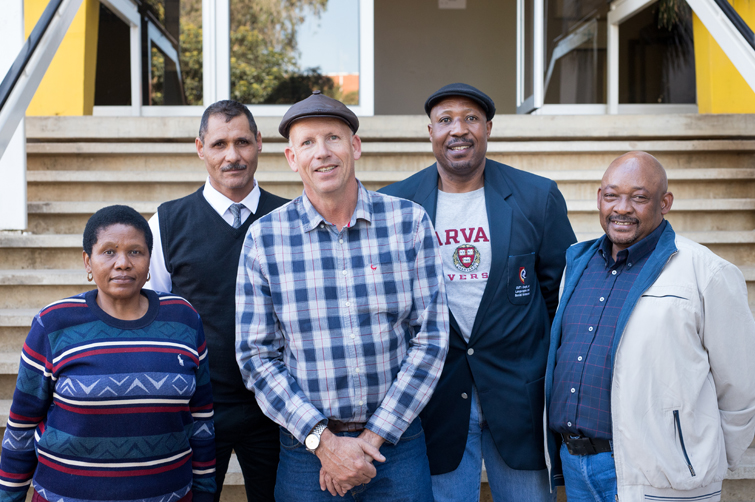Latest News Archive
Please select Category, Year, and then Month to display items
13 January 2020
|
Story Eugene Seegers
|
Photo Anja Aucamp
 Spearheading the digital expansion of the conversational Sesotho course is IDEAS Lab Director, Johann Möller (middle). With him are from the left: Prof Pule Phindane, CUT; Dr Brenton Fredericks, CUT; Bahedile Letlala, UFS Department of African Languages; and Dr Elias Malete, UFS Department of African Languages.
Spearheading the digital expansion of the conversational Sesotho course is IDEAS Lab Director, Johann Möller (middle). With him are from the left: Prof Pule Phindane, CUT; Dr Brenton Fredericks, CUT; Bahedile Letlala, UFS Department of African Languages; and Dr Elias Malete, UFS Department of African Languages.
For many years now, the UFS has been offering a one-year course in conversational Sesotho for staff members; this can then be followed up with the one-year course in advanced conversational Sesotho. The conversational Sesotho for students in the Faculty of Education was introduced in 2018 at the UFS.
The Central University of Technology (CUT) needed a conversational course for its first-year students and approached the Department of African Languages for the development of such a course. Living as we do in a multilingual country; this additional language skill opens doors and often hearts as well.
Using instructional design principles
However, the need was identified by both CUT and UFS to present this crucial information in a way that would be more appealing to digital natives as well as to those less familiar with technology. The Department of African Languages on the UFS Bloemfontein Campus, together with relevant departments from the CUT, approached the IDEAS Lab located on the UFS South Campus, since they already have a reputation for being a specialist on broadcasting and repackaging curricular content for digital presentations. The IDEAS Lab provided technical advice and built the multimedia programme, which will help the user to hear and practice phrases in Sesotho, using instructional design principles. The course will be available to both staff and students belonging to the two universities.
Room for growth
Johann Möller, Director of the IDEAS Lab, says this pilot programme will give both institutions the opportunity to test the use of multimedia for language acquisition. He adds, “Language is extremely complex, and we would like to expand this learning aid in the future.” In fact, the original design has room for growth built into it.
To keep things simple for the user and the building team, it was decided to start out with only four potential everyday scenarios where a staff member would like to speak Sesotho: Firstly, how to greet other persons from different genders; secondly, potential scenarios one might encounter in the university environment itself; thirdly, how to deal with situations at a hospital; and finally, how to use one’s language skills at a filling station.
Pronunciation is key
Each scenario contains three to four conversations that the learner can revise, along with images and audio that illustrate the situation and assist with correct pronunciation. The system does not allow the user to progress unless they have listened to the pronunciations of the sample sentences or phrases.
Further reading material and vocabulary lists are also provided, with the result that people who are using the programme can learn at their own pace. The authoring software Articulate Storyline was used to build the individual scenarios and each conversation or lesson within it. The lessons are also not dependent on an internet connection; they can be downloaded onto a flash memory drive and used offline.
Expert in Africa Studies debunks African middle class myth
2016-05-10

From left: Prof Heidi Hudson, Director of the Centre for Africa Studies (CAS), Joe Besigye from the Institute of Reconciliation and Social Justice, and Prof Henning Melber, Extraordinary Professor at the CAS and guest lecturer for the day.
Photo: Valentino Ndaba
|
Until recently, think tanks from North America, the African Development Bank, United Nations Development Plan, and global economists have defined the African middle class based purely on monetary arithmetic. One of the claims made in the past is that anyone with a consumption power of $2 per day constitutes the middle class. Following this, if poverty is defined as monetary income below $1.5 a day, it means that it takes just half a dollar to reach the threshold considered as African middle class.
Prof Henning Melber highlighted the disparities in the notion of a growing African middle class in a guest lecture titled A critical anatomy of the African middle class(es), hosted by our Centre for Africa Studies (CAS) at the University of the Free State on 4 May 2016. He is an Extraordinary Professor at the Centre, as well as Senior Adviser and Director Emeritus of the Dag Hammarskjöld Foundation in Sweden.
Prof Melber argued that it is misleading to consider only income when identifying the middle class. In his opinion, such views were advanced by promoters of the global neo-liberal project. “My suspicion is that those who promote the middle class discourse in that way, based on such a low threshold, were desperate to look for the success story that testifies to Africa rising.”
Another pitfall of such a middle-class analysis is its ahistorical contextualisation. This economically-reduced notion of the class is a sheer distortion. Prof Melber advised analysts to take cognisance of factors, such as consumption patterns, lifestyle, and political affiliation, amongst others.
In his second lecture for the day, Prof Melber dealt withthe topic of: Namibia since independence: the limits to Liberation, painting the historical backdrop against which the country’s current government is consolidating its political hegemony. He highlighted examples of the limited transformation that has been achieved since Namibia’s independence in 1990.